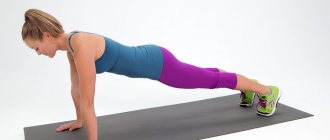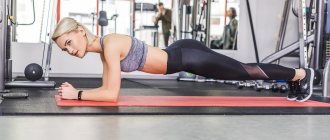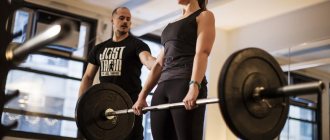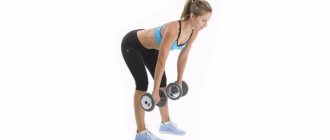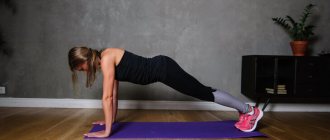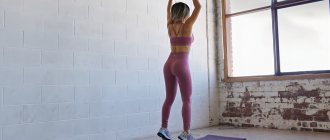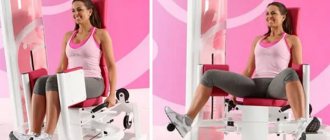Every fitness room has a rowing machine. This is sports equipment that simulates rowing on water. Exercises on such a setup belong to the category of cardio training. Exercise makes the heart work faster and is good for muscles and blood vessels. During training, a large number of muscles of the back, legs, shoulder girdle, biceps and abs work.
The rowing simulator provides a load that matches the effect that appears when descending river rapids.
Rowing machine
There are mechanical, hydraulic, aerodynamic and magnetic models. Regardless of the option, the essence of the settings is the same: the athlete sits on a bench, reminiscent of the one equipped on an ordinary boat, and pulls one or a pair of handles, which replace the oars. The movements performed are similar to exercises with a barbell, developing endurance and creating muscle relief on the back and arms.
Exercises and training program
The basic complex includes a short and long stroke. The exercises are performed in 3 sets, each with 10–20 repetitions.
Short stroke
Starting position (hereinafter referred to as I.P.): sitting, lower limbs bent at the knee joint, feet secured with belts. Arms extended forward, grip straight. Slowly push off with your feet, move back, and at the end point pull your arms to your chest. Smoothly in I.P.
Long stroke
IP: as with a short stroke, but the feet are fastened with straps so that the heels are slightly torn off the stop. The back is slightly rounded, the head is pulled forward, the arms are straightened, in a direct grip on the handles.
Push off with the front of the foot, moving backward, straightening the torso. At the same time, bend your elbows and pull the handle towards your collarbones. Smoothly in I.P.
The more you straighten your torso when performing the first phase of the exercise, the more your back and abdominal muscles are loaded.
It is recommended to tilt your torso 45 degrees.
Accented triceps training
IP: sit on the seat with your back forward, your legs are placed on the sides of the bench, resting on the floor, bent at the knees. With your arms bent at the elbow joints and behind your head, hold onto the handle. The arms are gradually straightened perpendicularly, giving a load to the triceps, then at the same pace they are returned to the starting position.
Targeted development of deltoid muscles
I.P.: standing in front of the simulator, legs spaced shoulder-width apart, back not rounded. The handle is held with palms down. Raise your arms until they form a parallel with the floor surface and lower them.
Training scheme
The content of the training program depends on the athlete’s preparation:
| Level | Training frequency per week (times) | How many approaches | Duration of the approach | Lesson duration (minutes) |
| Beginner (first 14 days) | 2–3 | 3 | 10 short and long strokes each | 15–20 |
| Average | 3 | 3 | 7 minutes | 30 |
| High | 4 | 5 | 10–12 minutes | 40–60 |
Take a 5-10 minute break between approaches. This time is intended for active rest, which involves stretching and light exercises to prevent the muscles from cooling down.
Exercises to increase the load
For those who find a regular session on a rowing machine not enough, you can add a little variety to it. A set of special exercises will increase the load and also pump up all muscle groups. To enhance the effect you need to do the following:
- It is necessary to fix the movable seat of the exercise machine in the extreme position, place your toes on it, and rest your hands on the floor. Knees bent. Start straightening your legs, moving the seat as far away from you as possible. This exercise resembles a plank and helps develop the muscles of the abs, back, buttocks, and thighs.
- Stand at the edge of the machine, bend over, and rest your hands on the seat. Roll it away from you, keeping your back straight and your knees straight. In terms of load, the exercise is similar to regular push-ups.
- The next task is performed from the same position, but now you need to put one leg on the seat. Start moving it away from you, gradually straightening it. The other leg, which is the supporting leg, bends at the knee.
- Now you need to turn your back to the machine. Place one leg on the seat and begin to move it back away from you. The second bends at the knee.
- You need to lie on your back at the edge of the machine. Place your feet on the seat. Lift your pelvis off the floor about 45 degrees. Start moving the seat away with your feet without lowering your body.
The proposed complex can become an option for independent training, or it can complement and diversify the main lesson. The exercises included in it will strengthen the leg muscles, which usually receive less stress when working with the apparatus.
To lose weight while working out at home, you can purchase a rowing machine. With regular exercise, it will allow you to quickly get rid of excess weight and keep the muscles of the whole body in good shape. The main thing is not to skip workouts and maintain a proper diet.
Execution technique
In order for the classes to bring maximum benefit, you have to learn the technique of movements. Strengthening your back and improving your silhouette occurs in 3–4 months. The stroke consists of two phases:
- craving;
- return.
Traction
The lower limbs are straightened, the body is tilted back. The back and legs are mainly loaded. Arms are straightened, shoulders relaxed. At the end of the movement, the arms are bent and the shoulders are extended. The body is slightly tilted, the legs are straightened. The handle is pulled towards the abdominal muscles.
Return
Move forward, starting from the hip. The seat of the projectile moves towards the flywheel mechanism, and the trajectory of the upper limbs does not intersect with the trajectory of the lower ones.
Recommendations and common mistakes
Every time before training, do a warm-up to increase blood circulation and prepare the body for further stress.
The normal duration of rowing machine sessions is 50 minutes. During this time, the athlete manages to complete three sets of exercises.
Classes begin with 20 minutes, gradually extending them. The load regulator (if provided by the model) is set to the lowest level. The main goal when mastering the installation is to tone the body.
Intense and long-term training is contraindicated during this period. A sign that you can increase the load is the absence of muscle discomfort.
The most common mistakes that result in diseases of the musculoskeletal system:
- when performing movements, the load falls on the knees, which leads to the development of joint disease;
- keep your back bent;
- make sudden movements or suddenly stop the exercise.
Stop training if your health worsens in any way—weakness, dizziness, nausea. Despite the benefits of the rowing simulator, people with certain heart and vascular diseases and cerebrovascular disorders are not allowed to participate in training.
Postponed training until recovery in case of acute bacterial and viral respiratory tract infections, high body temperature, or general malaise. Before starting training, consultation with a doctor is necessary if you have chronic illnesses or are over 35 years old.
User opinions
The rowing machine has positive reviews. Users say that such equipment is incredibly useful for training the heart and maintaining muscle tone. Despite the fact that rowing is difficult, the effect is amazing.
The rowing machine allows you to build and lose excess weight. The last advantage is highly appreciated by women.
Rowing machine for health and beauty
A rowing machine allows you to lose excess weight, give your body definition and strengthen your heart and blood vessels.
Users also like the fact that they can exercise on the exercise machine even at home, the main thing is that there is a place in the apartment to install it.
What is a trainer
The apparatus imitates rowing on the water, repeating the movements of oars as accurately as possible. Let's look at it in more detail.
Main functions of the device:
- develops and strengthens muscles, keeps them in good shape;
- effective for weight loss (burns fat deposits);
- stretches and strengthens tendons and ligaments;
- straightens posture, corrects coordination of movements.
Important! In case of spinal hernia or osteochondrosis, the load on the back during exercise on the exercise machine should be as gentle as possible. It is advisable to draw up a training program with a professional trainer. Capabilities and features of the sports instrument:
Capabilities and features of a sports instrument:
- brings exercises as close as possible to real rowing on water (some models, thanks to the built-in fan, imitate the blowing of wind);
- you can adjust the intensity of the workout (equipped with a timer);
- it is possible to monitor the pulse and other indicators of the body;
- easy to fold;
- easy to maintain;
- easy to move using special rollers;
- provided with stable supports.
The design and principle of operation of existing models may differ slightly, but the basis of all designs is the same:
- flywheel - provides tension and stretching of the cable;
- seat;
- handles (oars).
Currently there are 3 types of devices:
- Mechanical ones are compact, inexpensive, suitable for beginners, since they can easily adjust the degree of load.
- Magnetic - silent, equipped with a computer that allows you to select the program and intensity.
- Aerodynamic - more suitable for gyms, take up a lot of space, and are noisy. The package includes a fan that creates additional resistance to air flow.
Find out what is more effective for losing weight: a treadmill or an exercise bike.
Benefits and indications
Thanks to the large amplitude of movement, the effectiveness of working out almost all muscles is ensured: shoulders, back and abdomen, legs and arms, chest area. Indications for use and benefits of training on a rowing machine:
- improved blood circulation;
- improvement of lung function - tissues are saturated with oxygen;
- strengthening the heart muscle and blood vessels;
- normalization of the central nervous system;
- maintaining muscle tissue in tone, muscle relief;
- help in the fight against diseases and deformities of the spine.
Harm and contraindications
In addition to the benefits, sports activities on a rowing machine have a number of contraindications:
- brain disorders;
- serious heart disease;
- shoulder joint problems;
- displacement of intervertebral discs.
Important! If you have existing health problems, you should consult your doctor before starting exercise. The disadvantages of the simulator also include its dimensions: some designs take up a lot of space and can also make noise
The disadvantages of the simulator also include its dimensions: some designs take up a lot of space and can also make noise.
Advantages and contraindications - benefits and harm to the body
If we talk about the advantages of the simulator itself, it should be noted that:
If we note the benefits for the body, then there are, without a doubt, many advantages:
- strengthening the respiratory system - suitable for people who have a predisposition to acute respiratory infections, acute respiratory viral infections; bronchitis, asthma, etc.;
- increasing endurance and strengthening the cardiovascular system - this minimizes the likelihood of heart attacks, strokes, coronary artery disease and other diseases;
- normalization of the nervous system - increased resistance to stress, improved sleep;
- maintaining back health - correcting posture, improving the flexibility of joints and vertebrae;
- increased immunity - resistance to viruses, it will become easier to endure colds;
- the opportunity to build up the muscles of the upper body, create a broad-shouldered silhouette (but do not forget about nutrition for effective muscle growth);
- At the same time, as we said earlier, the simulator allows you to lose weight, because with intense half-hour rowing, a person weighing 60 kg can burn up to 500 kcal.
But even the best simulator has contraindications that harm the body:
In addition, there are also disadvantages:
Rowing technique on a rowing machine
1. Capture. The starting point of movement on a rowing machine is similar to a squat. The back is straight, the legs are tense and clenched, the arms are extended, the fingers hold the handle tightly. The body is slightly tilted, the chest is open and looking forward, the abs are tense, the latissimus dorsi muscles are relaxed.
2. Push. The movement begins with pushing off with the strength of the leg muscles and activating the shoulder girdle. Next, the biceps is activated, pulling the handle of the exercise machine towards the stomach. The back muscles open, pushing the chest forward. At the same time, the muscles of the thighs and buttocks straighten the leg at the knee.
3. Traction. The abdominal muscles are involved in the work, stabilizing the body position; buttocks and thigh muscles are tense. The arms, using the force of the biceps, pull the handle even closer to the belt - at the same time, the chest is pushed even further forward to increase the range of movement.
4. Recovery. The handle, held by the force of the triceps, moves forward. Next, bending slightly, the body moves forward (the abdominal muscles are tense and the back is straight). Only after this do the legs bend at the knees. The movement ends in the starting grip position.
Kinds
The principle of operation is described by the name of the simulator. It simulates rowing a boat. During training, more than 80% of the muscles are used. There are two types of simulator: magnetic and mechanical.
Mechanical
Suitable for those who are just starting out. Mechanical simulators are cheaper than magnetic ones. However, they have less functionality compared to more expensive shells.
Depending on the type of load, mechanics can be divided into aerodynamic and hydraulic. The aero rowing machine has fans. It creates air resistance. Hydraulic - spring projectiles. The operating principle is based on the elasticity of mechanical parts.
Magnetic
The projectile is almost silent, its movements are smooth. It is more durable compared to mechanical ones. Training on this machine is more comfortable due to its functionality. The magnetic system allows you to set different difficulty levels. There are also models in which you can separately regulate the load on your hands.
This type of projectile is more expensive than mechanical ones. They are more impressive in size. Therefore, not everyone can use them at home. They are equipped with an electronic system that shows the load, pulse, and counts calories burned. The magnetic system creates good resistance to the exerciser. It is easily adjustable, even without stopping the training process.
Frame assembly
Saw off 6 short pieces of 30 cm length from a wooden beam. Then cut both ends of each beam at an angle of 45 degrees. Now you need to saw off from the beam 6 bars 10 cm long each, 2 bars 18 cm long, 3 bars 40 cm long, 2 bars 42 cm long, 2 bars 19 cm long and 2 more bars 73 cm long. Finally, make 2 long bars of 170 cm each. Next, we cut out square recesses at one end of the bars 170 and 40 cm long. The depth of the recess should be half the section of the beam, that is, 2 cm, and the length and width should be 4 cm each Glue the 170 cm and 40 cm bars with wood glue, folding them at right angles in the grooves. Fasten the structure with two 30 cm long bars (with the corners already cut off), screwing them with two screws on the inside of the resulting right angle. Measure 3 cm from the edge at the opposite end of the 170 cm bar and drill a hole with a 15 mm drill. Drill a 1cm deep hole directly over this hole using a 32mm drill bit. Take the two resulting rectangular pieces and fasten them together with a 10cm long piece of wood, starting at the right angled edges. Secure the structure with clamps and let the glue dry. After this, add another 10 cm block at a distance of 25 cm from the edge, and another 83 cm from the edge. Take the last remaining 40 cm block. Measure 11 cm from both edges and put marks. We draw two squares 4 by 4 cm, the center of which will be the marks made. Along the drawn lines, cut a square recess 2 cm deep. Screw the 42 cm bars to the 73 cm bars, then drill a through hole in both with a 12 mm drill at a height of 20 cm. Now measure 120 cm and at this point screw the long beams of the not yet completed frame on top 42 cm bars. Next you need to screw the 18 cm bar on top of the long long ones - right between the 73 cm bars. Take another 18 cm bar and screw it between the upper edges of the 73 cm bars. Almost ready. It remains to screw 2 19 cm bars in a vertical position between the 18 cm bars, leaving a distance of about 2 centimeters between them. Next, it remains to screw four 30 cm bars with sawn off corners, fastening them to the right angles in the frame structure. Finally, fill the holes from screws with wood putty and sand them down. The frame is ready! Hooray!
Rowing machine
Rowing is a great, safe workout that allows you to stay in shape by working all major muscle groups while providing excellent cardio. Rowing is a gentle sport, safe for people of any age and level of physical fitness.
High quality rowing machines are relatively inexpensive, making them ideal for those on a budget but looking for a machine that provides a serious aerobic challenge.
The only caveat is that while rowing itself is unlikely to cause problems in the lower back, the rowing motion may worsen existing problems.
If you fall into the category of people who have lower back problems, first try out on a rowing machine at the gym to make sure it's the right machine for you.
Benefits of a rowing machine
Rowing is second only to skiing in terms of total load on all muscle groups, using 82% of all muscles in the body.
It also works most of the joints. This makes rowing one of the best exercises for all categories of people:
- For those who want to lose weight, get a cardio workout and tone their muscles
- For those who want to gain flexibility, strength and endurance
- For athletes participating in competitions
- For those recovering from injuries
- For people of any age
How to choose the right rowing machine
There are three types of rowing machines available for home use today.
- Air trainers use wind resistance created by built-in fan blades. This in turn starts the flywheel.
- Water simulators - work due to the resistance of water, simulating the movement of a boat through the water.
- Magnetic trainers – offer gentle and adjustable resistance. It uses a magnetic braking system.
What is important to know when choosing a rowing machine:
- Construction Quality – You should look for an all metal construction with a good finish, with an aluminum seat support. Sit on the seat - when you sit down, no part of the frame should bend.
- Braking System – Electronic rowing machines use a magnetic braking system and are nearly silent during use, but lack the quality of air and water trainers. Aerial trainers offer very high quality movement and precision reactions, but they can be a bit noisy. Aquatic machines maximize the sensation of rowing on water by producing soothing sounds like splashing water.
- Drivetrain – Look for a machine with chains or belts that provide a pleasant paddling sensation without extra effort or stretching.
- Quality of Movement – Choose a machine with a smooth movement so that there are no sudden jerks or moments where the resistance suddenly stops, especially at the beginning of the stroke (common with cable transfers). Check the range of motion with you leaning forward as far as possible (buttocks as close to your heels as possible), arms extended as far as possible and holding the oars, the oars should not return to the starting position.
- Convenient display – how clear and complete is the information on the display? Is it easy to choose a program? Are the buttons clearly visible and easy to use?
- Seat Comfort – The seat should be comfortable even if you have been paddling for several kilometers.
- Seat Rails and Support - Slide the seat into one end of the support and lift that end of the machine slightly. Good guides and support will allow the seat to roll freely to the other end.
- Oar handles – are the oars comfortable to hold? Can you grasp them tightly even when your hands are tired and sweaty?
- Adjusting the footrest - check that your feet are in a comfortable and safe position.
- Overall Dimensions – Rowing machines are usually small enough to keep at home, but have a long, narrow base. Some of them can be held in a vertical position, which is very convenient if space is limited.
- Warranty – Most home rowing machines are pretty reliable, but it’s a good idea to check what kind of warranty comes with the frame, drivetrain, and electronics.
Read more → Purchase of equipment
Article tags:
simulators
Hardening the body: the main thing is individual selection of procedures
Gymnastics for pregnant women - remember to be careful
Load settings
A very common mistake is the tendency to set the maximum load, but Frandsen completely disagrees with this: “In the 18 years that I have been rowing, I have never set the load level above 3-4 out of 10. Anything above this level imposes excessive stress on the body at the beginning of the stroke and can lead to injury.”
He recommends keeping the load low and practicing grip position and speed to learn how to handle the resistance of the water, rather than relying on the machine as the only source of load.
The only incline rowing machine on the market! The TOTAL GYM ELEVATE Row ADJ™ features 7 incline levels and integrates strength training into a traditional cardio machine for a complete, maximum-impact full-body workout. ELEVATE Row ADJ™ engages all muscle groups simultaneously and in a coordinated manner throughout the entire range of motion, ensuring proper and balanced loading. Read more >>>
How and how much to exercise
Any workout begins with a warm-up. Start with breathing exercises, then work out all muscle groups and ligaments, from exercises for the neck to the ankle joint. The intensity of movements increases gradually. By the end of the warm-up, your heart rate should be approximately 120 beats/min.
Rowing machine exercises
The duration of classes depends on the goal and physical fitness. For those just starting out, 10-15 minutes is enough. Those who have good physical fitness can exercise for 40-60 minutes.
To lose weight, exercises can be performed without breaks at such an intensity to maintain a constant pace, with the correct rowing technique.
Training can be interval training – alternating load and rest. This allows you to increase the intensity or duration of exercise. For example, 10-15 minutes – load; 2-4 minutes – rest, number of approaches – 2-3. Either 6-8 minutes – load, 3-5 minutes – rest, number of approaches – 3-5.
If you want to lose weight in your thighs, you need to add additional exercises to this area.
Relaxation
Every workout should end with relaxation. At this stage, it is necessary to restore your heart rate and be sure to perform stretching exercises.
If classes are conducted independently, you need to carefully plan the process, carefully monitor your well-being and monitor the results obtained. For this purpose, it is useful to keep a training diary. Its implementation disciplines and develops the habit of a systematic approach.
Using a rowing machine will help you lose weight if you use it for at least 30 minutes. and are repeated 3-4 times a week.
And lastly, it sounds trivial, but without changing your eating habits, it is very difficult to lose weight. At a minimum, you need to establish proper nutrition, but it’s better to consider one of the popular diets:
- Kremlevskaya
- Dukan
- Kefir
- Protein
Sources
- https://muscleoriginal.com/vybiraem-grebnoj-trenazher-dlya-doma/
- https://Sdelay-telo.ru/grebnye-trenazhery
- https://stroy-telo.com/trenirovka-v-zale/oborudovanie/kak-pravilno-zanimatsya-na-grebnom-trenazhere.html
- https://takioki.life/trenazher-greblya-dlya-doma/
- https://SdelaySam-SvoimiRukami.ru/4043-grebnoy-trenazher-svoimi-rukami.html
- https://muskul.pro/training/grebnoj-trenazher-instruktsiya-po-primeneniyu
- https://hudeyko.ru/grebnoy-trenazher-dlya-pohudeniya.html
How to train muscles effectively
The effectiveness of training depends on how correct the technique of performing the exercise is. In case of violations, the target muscles do not receive additional load, which affects the effectiveness of the training as a whole. In addition, failure to adhere to technique is a direct path to injury (cumulative or immediate).
First of all, you need to set the resistance or weight if we are talking about a block simulator
It is important to adequately assess your physical fitness in order to select the appropriate load. Do not start training with heavy weights or resistance
The athlete then sits on the bench with his feet in a sitting position resting on the platform and his knees slightly bent. The back is straight, the natural arch in the lower back is preserved. The head is also straight, the gaze is directed to the horizon line. Lowering your head down will put unnecessary strain on your neck. The first step is to pick up the handle without bending or rounding your back. The grip is comfortable, not too wide, approximately shoulder width or slightly narrower. If you want to round your back to reach the handle, you need to bend your knees a little more.
As you inhale, you need to push off the platform with your feet and straighten your legs, while at the same time pulling the handle of the device towards the body. When performing a push, make sure that the main load falls on the heels, the emphasis is on them.
Legs should be fully straightened, elbows pressed to the body. When pulling up your arms with the handle of the machine, you should bring your shoulder blades together (as is done when performing various lat pull-downs). You can lean back slightly (back straight) to increase the load on your lats. But the angle of inclination should be no more than 45 degrees.
As you exhale, you need to return to the starting position: first, the shoulder blades straighten, the arms straighten, the body leans slightly forward, and the knees bend.
Typically, training is carried out for a period of time (from 20 to 40 minutes). You can do an interval plan, combining work at a faster and moderate pace. This type of training is usually chosen by those who want to increase their endurance and lose weight.
An example of the simplest but most effective interval training on a rowing machine:
- rowing at a slow pace - 1 minute;
- the fastest speed for performing the exercise is 20 seconds;
- calm rowing – 1 minute;
- rowing at a fairly fast pace with 10 seconds of holding the body at the point of maximum tension (leaning back) - 1 minute;
- slow training – 1 minute;
- fastest pace – 1 minute;
- calm training – 2 minutes.
This is one circle, there can be from 2 to 8 depending on the goals and physical fitness of the athlete. You need to exercise 2-3 times a week.
Like any workout, rowing should be preceded by a warm-up. It is recommended to perform several general physical training exercises, as well as joint exercises. Afterwards - a cool-down, for example stretching.
All cardio exercises require plenty of fresh air. As a rule, there are no ventilation problems in fitness clubs. If training takes place at home, you need to first ventilate the room, but at the same time you cannot exercise in a draft.
You can find out why the rowing machine is considered the best for cardio and strength training in the video.
Exercise Tips
By following simple recommendations, you can achieve really good results and not harm your body:
Before starting a workout, you need to do a short warm-up to prepare your body for the stress; Regardless of the type of rowing machine, it is recommended to exercise for at least 40 minutes, but not more than 60 (untrained athletes are recommended to start with 20 minutes); Every 15-20 minutes it is recommended to take a break for 30-60 seconds, during which it is important not to stop physical activity (you can do squats, pump up your abs, etc.); It is important to ensure correct posture so that during traction and abduction of the body the tilt is 45 degrees or more; To involve the maximum number of muscles in the work, it is recommended to change the position of the hands when gripping, making it alternately with palms up and down.
The main advice concerns the frequency of classes. To get truly noticeable results in improving your physical fitness, you need to exercise at least 3 times a week on a regular basis.
The nuances of training on rowing machines
If you decide to purchase a rowing machine for your home, which one is better is up to you to decide. This is a great opportunity to practice rowing in comfortable and convenient conditions. During classes, you can watch movies and listen to music, which makes the workout more interesting.
But you should always remember that systematicity is important when training on a rowing machine (or any other machine). If it is not there, visible results will not be achieved quickly. Therefore, plan your workouts carefully and try to do them regularly.
Why 60 minutes? One of the reasons is that fat tissue will begin to be burned only 20-30 minutes after the start of the workout.
During classes, you can watch movies and listen to music, which makes the workout more interesting
At the same time, it is important to calculate your strength and not overexert yourself, since classes lasting more than 60 minutes can lead to overwork, which negatively affects the overall effectiveness of the workout.
What to look for when choosing to study at home
There are several types of rowing machine. Mechanical, magnetic and electromagnetic are distinguished. Each of them has certain features and differs in price.
It is believed that for those who have just started playing sports and want to buy such a home exercise machine for weight loss, a mechanical one is best suited. Plus, it's the least expensive option, so anyone can afford it. In terms of its dimensions, it is not very large, it will easily fit in an apartment.
Another option is a magnetic rowing machine. It is similar in many ways to the mechanical variety, but one of its main differences is a different way of regulating the load. In addition, it is smoother and easily helps to work all muscle groups.
Of course, the most ideal option is an electromagnetic rowing machine. When exercising on it, you feel absolutely no jerks, it works silently and lasts a very long time. Such a simulator is unlikely to be suitable for beginners with a low level of physical fitness. After all, its main goal is to create conditions as close as possible to those that exist during real rowing.
Electromagnetic rowing machine
To choose the right exercise machine that will help you lose weight, it is important to pay attention to some parameters. The ideal set of features is:
- in order not to worry about the fact that the charge may suddenly run out in the middle of a workout, it is better to choose the option with a built-in generator;
- there should be the possibility of stepwise regulation of the load level;
- it is important that a device is present that measures heart rate;
- the display of the simulator should display the most basic data that needs to be monitored during exercise: heart rate, distance traveled, number of calories burned, time, rowing movements;
- for the convenience of performing exercises, it is important that the seat and handles are adjustable;
- A useful bonus to the simulator will be a fat analyzer, which will allow you to monitor the progress of your workouts in real time.
Not every rowing machine has a complete list of all parameters. But if the presence of any of them is not fundamentally important, you can buy an option that will work without them.
How to choose
Working out in a gym has undeniable benefits, but not everyone can afford them. There are many reasons - from lack of time to financial difficulties. Therefore, sometimes it is easier to buy a machine and practice at home.
Training at home also has significant advantages:
- no time wasted on travel;
- classes are held at a convenient time;
- there is no psychological discomfort, especially at the beginning of training, while the figure and technique are far from ideal.
If the decision has been made, all that remains is to figure out how to choose a rowing machine. Let us emphasize once again - it is not very suitable for losing weight in the lower body. In this case, you should think about a different type of exercise machine (exercise bike, orbitrack, stepper).
If this is exactly what you need, we move on to choosing a specific model. According to the principle of creating a load, rowing machines are:
- mechanical;
- magnetic;
- aeromagnetic.
The first two are suitable for home use.
Mechanical models
Mechanical rowing machine Leco It-Pro Plus
In the mechanical version, hydraulic pistons provide resistance, so operation may be accompanied by noise and uneven movement is possible. More expensive models guarantee smooth running and silent operation.
The load adjustment is stepless. Typically, the set of parameters recorded by the computer unit is small: training time, number of strokes, energy consumption.
Mechanical models are simple, lightweight, inexpensive devices that allow you to train effectively. Suitable for beginners. Prices are determined by the material and set of functions of the computer unit.
Magnetic models
Magnetic rowing machine HS-030R BOOST
Higher class devices. You can choose the load level. It is adjusted using a flywheel; the heavier it is, the higher the load and the smoother the ride. Models of this type operate almost silently, allowing you to perform not only the “rowing” exercise, but also many additional ones, which provides expanded training opportunities.
The computer unit records a wide range of parameters and helps to build various training programs. Suitable for experienced users. The devices are compact, easy to fold, and can be powered by batteries. The price depends on the material, the functional set of the computer and the weight of the flywheel.
When choosing a simulator, you need to take into account the weight, dimensions, whether it can be folded if necessary, how easy it is to do, whether there are transport rollers
You should also pay attention to whether the seat is comfortable, whether the handles are covered with a layer of non-slip material, whether the position of the rowing levers and footrest can be adjusted
Whatever exercise machine you choose, the main thing is not to postpone the start of training until next Monday. Don't let your laziness distract you from your goal. Start today, right now, and the results will definitely come.
Training on the simulator
For complete and effective training, beginners will need advice from professional trainers.
Training Recommendations
Let's look at what you need to consider when training on a rowing machine:
- You need to exercise in comfortable, loose clothing that does not restrict movement.
- Shoes should not slip.
- Drink water between sets.
- Before exercise, the muscles need to be warmed up with a warm-up, and afterward they need to be worked on with restorative stretching.
- It would be correct to start the lesson with medium intensity (up to 25 strokes per minute).
- All movements should be smooth, without sudden jerks.
- Do not overstrain your knee joints.
- There is no need to lean forward too much when following the cable.
- If painful sensations occur, you need to slow down the pace or change the manner of performing the exercise.
Did you know? In 1992, English athlete Steve Redgrave won his third gold medal at the Barcelona Olympics in rowing while suffering from diabetes.
Exercise technique
The effect of the workout will depend on how correctly you do it. Basic principles of the technique:
- Starting point: legs bent at the knees, feet standing straight, palms clasping the handles of the exercise machine. The back is straight with a slight bend forward, its muscles are relaxed, the abs and triceps are tense.
- Starting the movement: tense your shoulders and use your legs to push away from the support. Simultaneously with the push, straining your arms, pull the cable toward you to the area under your chest. During the movement, the back is leveled, the thoracic region “comes forward”, the legs are straightened.
- Completion point: the handles of the exercise machine are as close to the body as possible, the abdominal muscles are tense, the elbows are pulled back. At the end of the movement, the hips and buttocks tighten.
- Returning to the starting point: overcoming resistance, smoothly release the cable away from you while holding the handles. Slowly leaning forward with your body, bend your knees.
Training scheme
Let's consider an approximate training program for different levels of training:
| Level | Number of workouts per week | Number of approaches | Number or duration of strokes | Duration of training (in minutes) |
| newbie | 2–3 | 3 | 10 short, 10 long | 15–20 |
| average | 3 | 3 | 7 minutes | 30 |
| professional | 4 | 5 | 10–12 minutes | 40–60 |
class="table-bordered">
Discovering the Benefits of Rowing, Exercise for the Superman
The full body workouts associated with rowing place enormous demands on the aerobic and anaerobic systems of the body. The greater the load on the body, the greater the forced adaptation to it.
Over time, the body creates more capillaries to carry blood and oxygen to working muscles, the muscles around the heart strengthen and grow, and the lungs become more efficient at extracting oxygen from the air.
So it's no surprise that with high volumes of rowing training, elite rowers achieve such impressive VO2 max - the maximum rate at which the heart, lungs and muscles can effectively use oxygen during training.
In another example of the positive training effects of rowing, five Olympic gold medal winner Sir Steve Redgrave trained his heart to be so fit that he had a resting heart rate of 36 beats per minute. The average man's resting heart rate is between 60 and 70 beats per minute. So, if there's one thing we can be sure of, it's that rowing is a great physical development activity.
What muscles work
The following groups are involved in the work:
- body: back muscles - rectus abdominis, rhomboids, latissimus, as well as arm muscles (including biceps), chest muscles, shoulder girdle, less - abdominal muscles;
- lower body (to a lesser extent): quadriceps, buttocks.
Grip options
The execution is varied by alternating grips:
| Type of grip | Loaded muscle groups |
| Straight (classic) | If the palms are directed downwards, then the back muscles and triceps work |
| Back | Palms facing, biceps, chest, back, shoulder muscles are loaded |
In addition, by changing the position of the hands, it is possible to redirect the load to different muscle groups.

